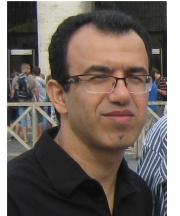Optimization of Compost Leachate Treatment Using Advanced Oxidation Process)AOP (H2O2/UV
Author(s):
Abstract:
Composting is certainly one of the most natural types of recycling process. One of the problems during this process is the management of leachate that adversely affects human and ecological health in the area. Leachate is a complex organic compound which is difficult to be degraded biologically by conventional methods. Advanced oxidation processes (AOPs) have been widely studied for the degradation of diverse types of industrial wastewaters. The purpose of the study was aimed to evaluate the efficiency of hydrogen peroxide with ultraviolet light (H2O2/UV) for the treatment of high chemical oxygen demand (COD) strength compost leachate, color and turbidity using response surface methodology (RSM) under central composite design (CCD). The various operation conditions such as initial pH, dose of hydrogen peroxide, and UV-contact time was examined in order to optimize the maximum COD and color removal and turbidity of the compost leachate. The total number of 20 experimental runs was set. Optimal condition obtained for H2O2/UV process were initial pH 7.5, dose of hydrogen proxide 2.3 mL/L, and UV-contact time 95 min. In these conditions, the removal of COD and color and turbidity for H2O2/UV process was 12.32%, 20.83%, and 8.68 NTU, respectively. The results indicated that the H2O2/UV process has been successful in reducing turbidity but in COD removal efficiency is not well. Composting is certainly one of the most natural types of recycling process. One of the problems during this process is the management of leachate that adversely affects human and ecological health in the area. Leachate is a complex organic compound which is difficult to be degraded biologically by conventional methods. Advanced oxidation processes (AOPs) have been widely studied for the degradation of diverse types of industrial wastewaters. The purpose of the study was aimed to evaluate the efficiency of hydrogen peroxide with ultraviolet light (H2O2/UV) for the treatment of high chemical oxygen demand (COD) strength compost leachate, color and turbidity using response surface methodology (RSM) under central composite design (CCD). The various operation conditions such as initial pH, dose of hydrogen peroxide, and UV-contact time was examined in order to optimize the maximum COD and color removal and turbidity of the compost leachate. The total number of 20 experimental runs was set. Optimal condition obtained for H2O2/UV process were initial pH 7.5, dose of hydrogen proxide 2.3 mL/L, and UV-contact time 95 min. In these conditions, the removal of COD and color and turbidity for H2O2/UV process was 12.32%, 20.83%, and 8.68 NTU, respectively. The results indicated that the H2O2/UV process has been successful in reducing turbidity but in COD removal efficiency is not well. The results indicated that the H2O2/UV process has been successful in reducing turbidity but in COD removal efficiency is not well.
Keywords:
Language:
Persian
Published:
Quranic Knowledge Research, Volume:17 Issue: 2, 2017
Pages:
247 to 258
magiran.com/p1716203
دانلود و مطالعه متن این مقاله با یکی از روشهای زیر امکان پذیر است:
اشتراک شخصی
با عضویت و پرداخت آنلاین حق اشتراک یکساله به مبلغ 1,390,000ريال میتوانید 70 عنوان مطلب دانلود کنید!
اشتراک سازمانی
به کتابخانه دانشگاه یا محل کار خود پیشنهاد کنید تا اشتراک سازمانی این پایگاه را برای دسترسی نامحدود همه کاربران به متن مطالب تهیه نمایند!
توجه!
- حق عضویت دریافتی صرف حمایت از نشریات عضو و نگهداری، تکمیل و توسعه مگیران میشود.
- پرداخت حق اشتراک و دانلود مقالات اجازه بازنشر آن در سایر رسانههای چاپی و دیجیتال را به کاربر نمیدهد.
In order to view content subscription is required
Personal subscription
Subscribe magiran.com for 70 € euros via PayPal and download 70 articles during a year.
Organization subscription
Please contact us to subscribe your university or library for unlimited access!


